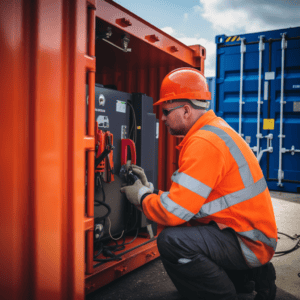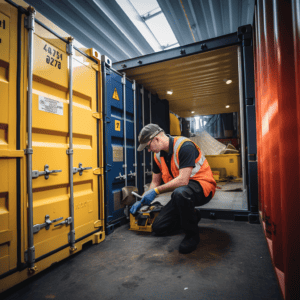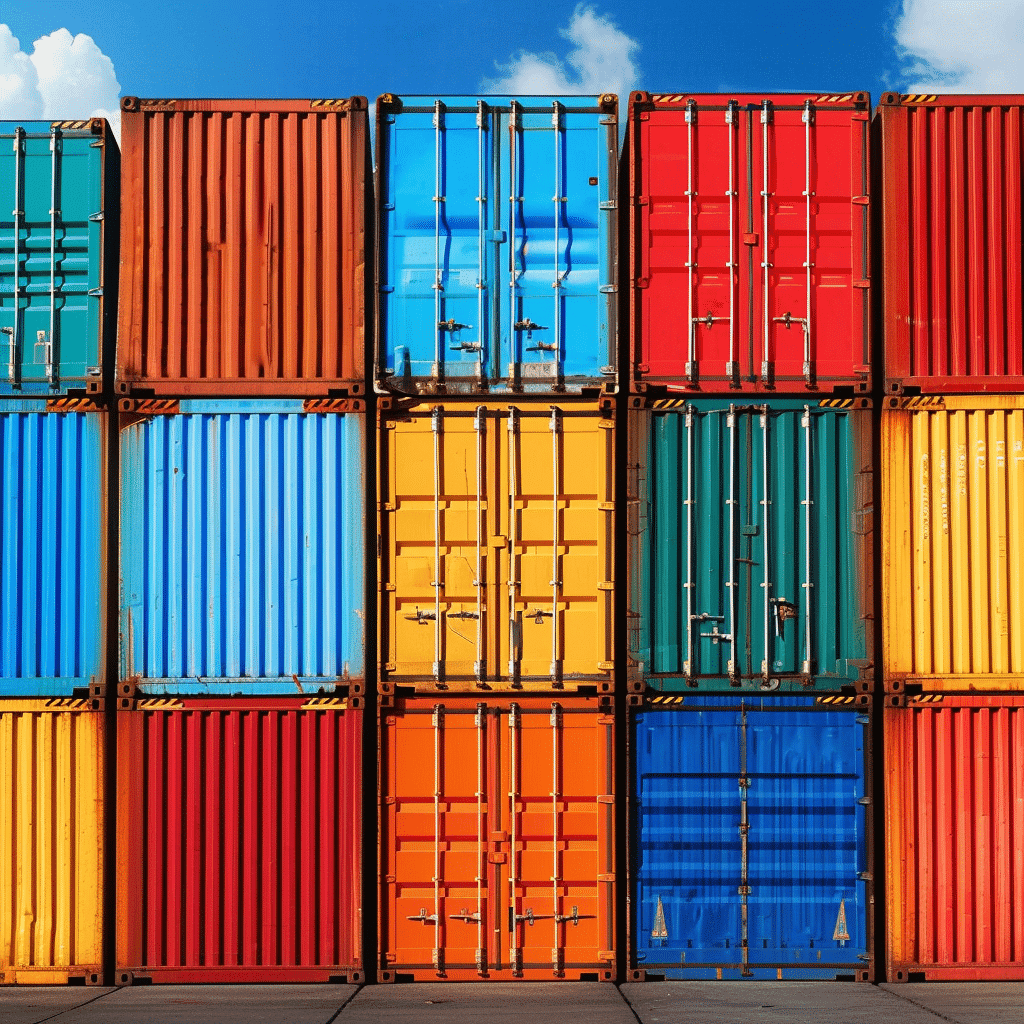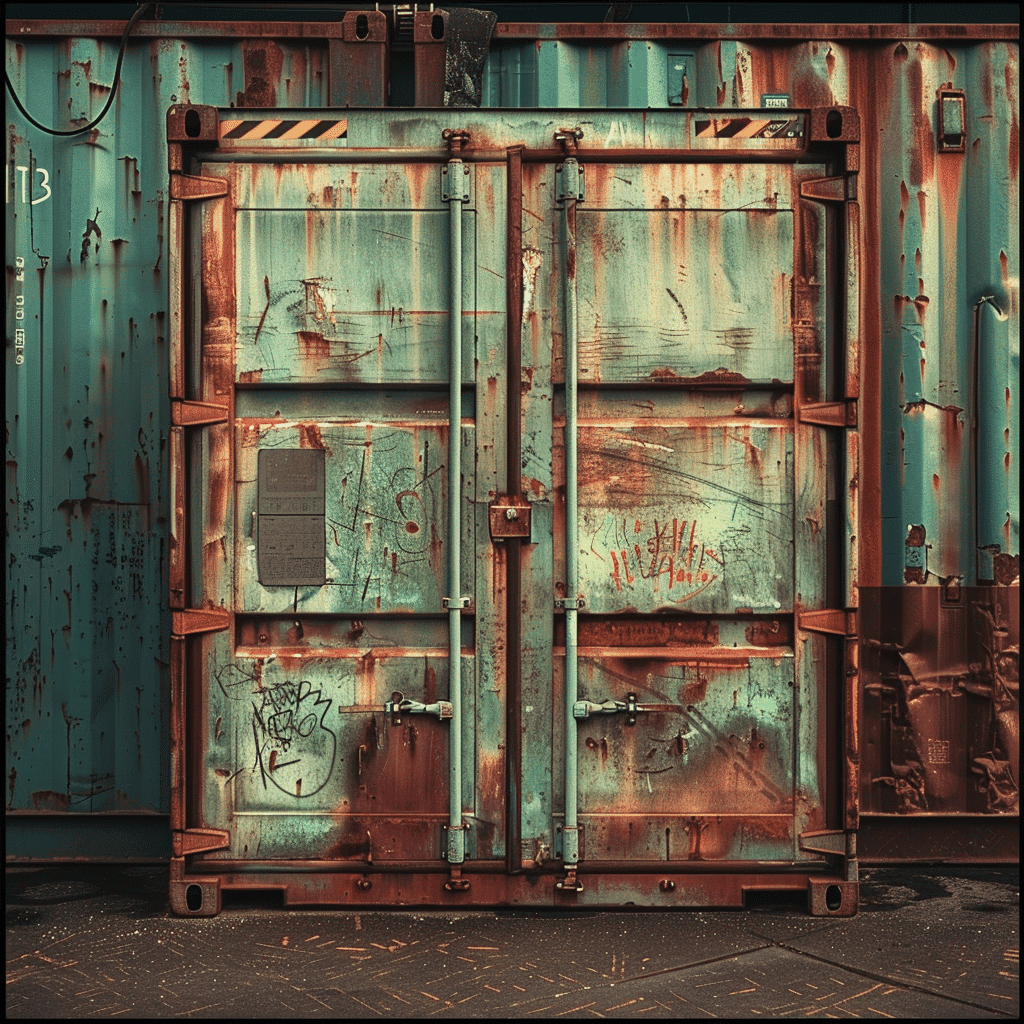Just like you wouldn’t ignore a check engine light, you can’t neglect storage container maintenance. This guide will equip you with the knowledge and tools to keep your container in top shape.
From understanding container materials to essential maintenance practices, you’ll learn the ins and outs of container care.
Let’s dive in, and you’ll soon be able to tackle any container maintenance task that comes your way.
Understanding Container Materials and Basic Care
Before diving into specific maintenance strategies, it’s crucial that you understand the materials used in your storage containers and how to provide basic care.
Most shipping containers, including steel shipping containers, are made of corten steel. This material is durable, but like all metal parts, it’s susceptible to wear and tear. The container roof is often the most vulnerable, as it’s exposed to the elements.
Regular maintenance is key to keeping your container in top condition. This includes checking for rust, sealant deterioration, and other damage.

Corten Steel Properties Explained
You might be wondering what makes Corten steel so ideal for storage containers. This kind of metal, also known as corten steel, has unique properties that make it incredibly durable.
Unlike other types of steel, Corten doesn’t rust in the traditional sense. Instead, the surface develops a protective layer of corrosion when exposed to moisture. This layer, instead of damaging the structure, actually serves to protect the metal underneath from further rusting. This process gives Corten steel an extended lifespan, making it a cost-efficient choice for storage containers.
With its superior durability and resistance to the elements, it’s no wonder Corten steel is a popular choice. Remember, proper care can further enhance these properties, ensuring your container lasts even longer.
Essential Maintenance Practices
Maintaining your Corten steel storage container properly isn’t just about preserving its physical appearance; it’s also crucial for maximizing its lifespan and overall functionality.
Essential maintenance practices involve regular inspection to identify potential damage early, facilitating timely repairs. Pay close attention to door hinges, which require periodic lubrication to maintain them in good working order. Lubrication not only ensures smooth operation but also helps to prevent rust.
Remember, storage container maintenance and care isn’t a one-time task but a regular commitment. By adhering to these practices, you’re not just ensuring that your container remains visually appealing, you’re also enhancing its efficiency and durability.
This dedication to maintenance will save you money and headaches in the long run.
Special Considerations for Different Container Types
While adhering to general maintenance practices, it’s essential to consider that different types of containers may require specific care and attention. For instance, locking bars on some containers can rust over time. Regularly using a wire brush to remove surface rust can prevent further damage and ensure smooth operation.
Standing water on your container’s roof can cause rust and leaks. Regularly check and drain any accumulated water to avoid these issues.
For containers with doors and windows, ensure they’re free from large dents that might affect their functionality. If you spot any dent, it’s best to repair it promptly to prevent further complications.
Seasonal Maintenance Tips
Seasonal changes can significantly impact the condition of your storage container, making tailored maintenance practices essential throughout the year. In summer, it’s crucial to check for and mitigate rust caused by increased humidity and to ensure proper ventilation to avoid internal condensation. During winter, frequent inspections for snow or ice accumulation on the roof are necessary to prevent structural strain.
In areas prone to heavy rainfall, ensure that the container is placed on well-drained ground to avoid water pooling, and regularly clear debris from drainage areas to prevent water ingress. There are also ways you can keep moisture out of storage containers.
Additionally, applying weather-resistant sealants can provide extra protection against seasonal weather variations, helping to maintain the integrity and longevity of your container in diverse climatic conditions.
Preventive Measures for Container Longevity
There are a lot of factors impacting container lifespan. To maximize the lifespan of your storage container, adopting preventive measures is key. Start by choosing an optimal placement location, ideally on a level, paved surface to minimize direct contact with soil and moisture, which can accelerate corrosion. Regular application of protective coatings, such as rust inhibitors and weather-resistant paint, is essential to shield the container from environmental elements like rain, salt air, and extreme temperatures.
Ensuring adequate drainage around the container helps prevent water accumulation, which is a primary cause of rust. Additionally, installing roof covers or canopies can provide extra protection against direct sunlight and precipitation. By proactively managing these aspects, you can significantly reduce wear and tear, thereby extending the container’s functional life and maintaining its structural integrity.

Storage Container Maintenance
Now that you’ve grasped the special considerations for different types of containers and different container sizes and dimensions, let’s delve into the specifics of routine storage container maintenance.
Regularly inspecting your container is crucial. Look for any damaged areas, particularly around the doors and hinges, as these spots are prone to wear and tear. Repair any issues promptly to protect your container from further damage.
A key part of storage container maintenance is to prevent water damage. Ensure the container is properly sealed and weatherproof to keep your items safe. Regularly cleaning the container will also help to maintain its condition and longevity.
Modified Container Maintenance
In addition to standard containers, you’ll need to take extra care with modified storage containers to ensure they remain in good condition. Modified container maintenance can be a bit more intricate.
Excess moisture, debris, and dirt can cause expensive and costly repairs if not addressed promptly. Regularly check the container for any leaks or signs of moisture. If you discover any, act quickly to secure the area and replace any damaged parts.
Clear away any debris or dirt that can accumulate and lead to deterioration. By taking these steps, you’ll keep your container in peak condition and avoid unnecessary repairs.
Common Shipping Container Repairs
Having understood the importance of regular maintenance, you’re better equipped to tackle common shipping container repairs that may arise over time.
Some moving parts, like door hinges, often require lubrication to extend their life. Tools like a good quality lubricant can help ward off the tear and wear caused by elements such as rust.
Properly storing your container can also reduce the risk of damage. The better you store, the longer its life. Protecting your container from harsh weather conditions can add years to its long life.
Regular maintenance and timely repairs will ensure your shipping container remains in top shape ready for use. Remember, small efforts can lead to big savings in the long run.
Frequently Asked Questions
How do you maintain a storage container?
Maintaining a storage container involves several key practices to ensure its longevity and functionality. Firstly, it’s crucial to position the container on level ground to prevent structural strain and water accumulation. Care should be taken when operating vehicles near the container to avoid impacts and damage.
Regular cleaning of the container is important to remove dirt, debris, and prevent rust formation. The door hinges of the container require periodic lubrication to keep them functioning smoothly. It’s advised not to load heavy objects on the roof of the container, as this can lead to structural damage. Finally, objects should be placed gently inside the container to avoid internal damage. These practices help in preserving the container’s condition and extending its useful life.
Do shipping containers need maintenance?
Yes, shipping containers do require maintenance to ensure their durability and longevity. While they are designed to be robust and withstand harsh conditions, they are not completely infallible. Routine maintenance is necessary to keep them in top condition and to maximize their lifespan. This maintenance includes inspecting the container for scratches, dents, and peeling paint, and addressing any issues as needed.
It’s also important to check for structural integrity, such as ensuring the floor is level and not buckling. Regular maintenance helps prevent failures and guarantees optimal operation, especially for specialized containers like reefers or insulated units. Properly maintained containers are crucial for avoiding delays, additional costs, or the loss of valuable goods stored within them.
What is container maintenance?
Container maintenance refers to the systematic process of inspecting, testing, cleaning, and repairing equipment within a container terminal. This process is crucial for ensuring the optimal functioning and longevity of the equipment. It encompasses various safety measures implemented to prevent accidents and protect workers in the terminal environment.
Regular maintenance activities include checking the structural integrity of containers, addressing surface rust, and ensuring that all moving parts, like door hinges, are in good working order. The goal of container maintenance is to maintain the container’s condition, thereby ensuring the safety and security of the goods stored inside and facilitating smooth operations within the terminal.
What are the signs that a shipping container requires maintenance?
Signs that a shipping container requires maintenance include the presence of rust and mold, which are major indicators of deterioration. The roof of the container is particularly important to monitor, as it can be a weak spot if not properly maintained. A sagging or compromised roof can signal structural integrity issues. Additionally, the condition of the floors can indicate whether the container is on an unlevel surface, which can lead to further damage.
The functionality of doors and windows is also a key aspect to check; difficulties in opening or closing them can suggest maintenance needs. Lastly, damaged gaskets and hinges are clear signs that the container requires attention. Luckily, you can prevent and avoid mold in shipping containers. Regular inspections for these issues can help maintain the container’s condition and prolong its usability.
Conclusion
With your container’s longevity and effectiveness hinging on regular maintenance and timely repairs, it’s clear that your care and attention can make a significant difference.
storage container maintenance and care is a task that you shouldn’t take lightly. Be vigilant for signs of wear and tear, as these can make your container prone to leaks.
Keep your equipment in working order, whether you own or rent your storage container. Regular checks before and after loading can help you reach a long life span for your container.


